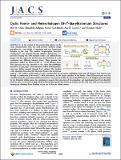Por favor, use este identificador para citar o enlazar a este item:
http://hdl.handle.net/10261/331186COMPARTIR / EXPORTAR:
 SHARE SHARE
 CORE
BASE CORE
BASE
|
|
| Visualizar otros formatos: MARC | Dublin Core | RDF | ORE | MODS | METS | DIDL | DATACITE | |

| Título: | Cyclic Homo- and Heterohalogen Di-λ3-diarylhalonium Structures |
Autor: | Chen, Wei W.; Artigues, Margalida; Font-Bardia, Mercè; Cuenca, Ana B.; Shafir, Alexandr CSIC ORCID | Palabras clave: | Cyclic diaryliodonium salts Halogens |
Fecha de publicación: | 28-jun-2023 | Editor: | American Chemical Society | Citación: | Journal of the American Chemical Society 145 (25): 13796–13804 (2023) | Resumen: | In the context of the ever-growing interest in the cyclic diaryliodonium salts, this work presents synthetic design principles for a new family of structures with two hypervalent halogens in the ring. The smallest bis-phenylene derivative, [(C6H4)2I2]2+, was prepared through oxidative dimerization of a precursor bearing the ortho-disposed iodine and trifluoroborate groups. We also report, for the first time, the formation of cycles containing two different halogen atoms. These present two phenylenes linked by hetero-(I/Br) or -(I/Cl) halogen pairs. This approach was also extended to the cyclic bis-naphthylene derivative [(C10H6)2I2]2+. The structures of these bis-halogen(III) rings were further assessed through X-ray analysis. The simplest cyclic phenylene bis-iodine(III) derivative features the interplanar angle of ∼120°, while a smaller angle of ∼103° was found for the analogous naphthylene-based salt. All dications form dimeric pairs through a combination of π-π and C-H/π interactions. As the largest member of the family, a bis-I(III)-macrocycle was also assembled using the quasi-planar xanthene backbone. Its geometry enables the two iodine(III) centers to be bridged intramolecularly by two bidentate triflate anions. In a preliminary manner, the interaction of the phenylene- and naphthalene-based bis-iodine(III) dications with a new family of rigid bidentate bis-pyridine ligands was studied in solution and the solid state, with an X-ray structure showing the chelating donor bonding to just one of the two iodine centers. | Versión del editor: | https://doi.org/10.1021/jacs.3c02406 | URI: | http://hdl.handle.net/10261/331186 | DOI: | 10.1021/jacs.3c02406 | ISSN: | 00027863 |
| Aparece en las colecciones: | (IQAC) Artículos |
Ficheros en este ítem:
| Fichero | Descripción | Tamaño | Formato | |
|---|---|---|---|---|
| jacs.3c02406.pdf | Artículo principal | 2,93 MB | Adobe PDF |  Visualizar/Abrir |
CORE Recommender
PubMed Central
Citations
1
checked on 13-abr-2024
SCOPUSTM
Citations
4
checked on 29-abr-2024
WEB OF SCIENCETM
Citations
3
checked on 29-feb-2024
Page view(s)
26
checked on 30-abr-2024
Download(s)
29
checked on 30-abr-2024
Google ScholarTM
Check
Altmetric
Altmetric
Artículos relacionados:
NOTA: Los ítems de Digital.CSIC están protegidos por copyright, con todos los derechos reservados, a menos que se indique lo contrario.


